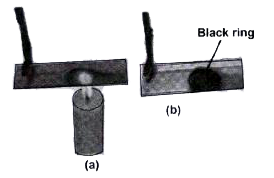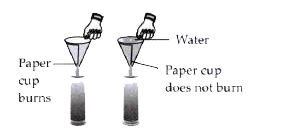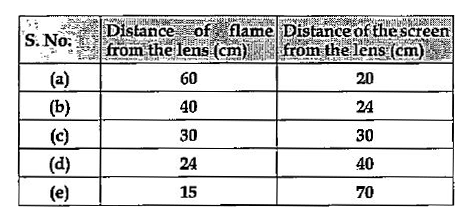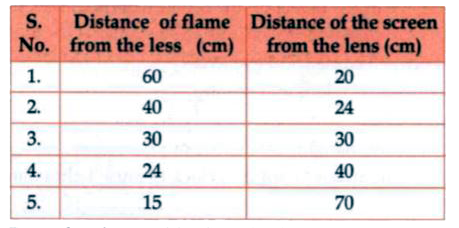When you introduce a glass plate into the luminous zone of a candle flame for a few seconds, the observation is as shown in figure (b). What does the observation indicate?

A
Deposition of burnt particles present in the air around the flame.
B
Deposition of unburnt carbon particles in the luminous zone of the flame.
C
Deposition of molten wax.
D
All of these.
Video Solution
Text Solution
The correct Answer is:B
Luminous zone, is the yellow zone, where incomplete combustion takes place because in this zone, the combustible vapours do not get sufficient oxygen to burn. Thus when a glass plate is introduced in luminous zone some unburnt carbon particles remain and cause black deposition.
|
Topper's Solved these Questions
- COMBUSTION AND FLAME BOOK - MTG IIT JEE FOUNDATIONCHAPTER - COMBUSTION AND FLAME EXERCISE - EXERCISE (MATCH THE FOLLOWING) LEVEL 1
5 Videos
- COMBUSTION AND FLAME BOOK - MTG IIT JEE FOUNDATIONCHAPTER - COMBUSTION AND FLAME EXERCISE - EXERCISE (ASSERTION & REASON) LEVEL 1
10 Videos
- COMBUSTION AND FLAME BOOK - MTG IIT JEE FOUNDATIONCHAPTER - COMBUSTION AND FLAME EXERCISE - NCERT SECTION
18 Videos
- COAL AND PETROLEUMBOOK - MTG IIT JEE FOUNDATIONCHAPTER - COAL AND PETROLEUMEXERCISE - OLYMPIAD/HOTS CORNER
10 Videos
- FOOTSTEPS TOWARDS (JEE MAIN)BOOK - MTG IIT JEE FOUNDATIONCHAPTER - FOOTSTEPS TOWARDS (JEE MAIN)EXERCISE - SECTION B (NUMBERIC VALUE TYPE QUESTIONS)
10 Videos
Similar Questions
Knowledge Check
Cheenu sets up an experiment as shown in the figure.

What do you think would Cheenu's observation and conclusion be?APaper cup with water does not burn.BTemperature of water rises.CPaper cup loses the heat to the water by conduction.DAll of these.A student focussed the image of a candle flame on a white screen by placing the flame at various distances from a convex lens. He noted his observations as:

What is the change in image observed as the object is moved from infinity towards the concave lens?ASize of image decreasesBSize of image becomes highly diminishedCSize of the image remains unchangedDSize of the image increases slightlyA student focussed the image of a candle flame on a white screen by placing the flame at various distances from a convex lens. He noted his observations as :

What type of lens is a convex lens?ADiverging lensBConverging lensCFlat lensDNon-converging lens
What makes the middle zone of a candle flame luminous (or light-giving) ?
View SolutionHow will you prove that luminous zone of a candle flame contains unburnt particles of carbon? Demonstrate with an experiment.
View SolutionWhat happen when you rub your hands vigorously for a few seconds ? Why does this happen ?
View SolutionA cardiologist observed an enlarged QR wave in the ECG of a patient. What does it indicate ?
View SolutionA cardiologist observed an enlarged QR wave in the ECG of a patient. What does it indicate ?
View Solution

